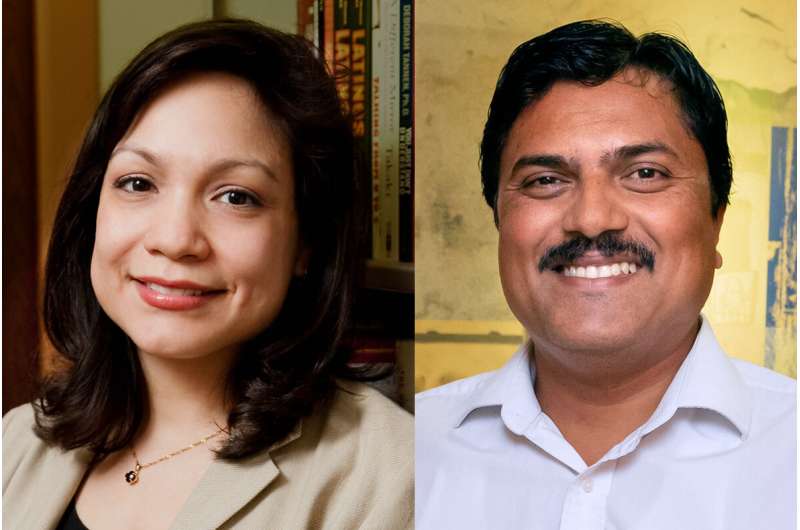Study examines India's policies for financial inclusion of the unbanked

Globally, 1.7 billion people do not have a bank account, and policymakers struggle to provide affordable, safe and accessible financial services to the unbanked population.
Despite India's long history of financial inclusion initiatives, the country has had limited success at drawing its most vulnerable citizens into using banks and financial services rather than high-cost or risky arrangements such as borrowing from moneylenders or hiding cash under a mattress.
Doctoral student Gaurav R. Sinha and social work professor Lissette M. Piedra at the University of Illinois at Urbana-Champaign examined some of the policies that India implemented over a 24-year period to determine why a large proportion of its citizens remained unbanked.
With about 190 million unbanked adults, India is second only to China among developing countries in the number of residents who don't have bank accounts or participate in the formal financial sector, according to World Bank.
While millions of basic bank accounts were opened under one policy mandate, and 80% of Indian adults owned a bank account at the time of the study, half of these accounts were inactive, according to the researchers.
Sinha and Piedra analyzed 36 of India's financial-inclusion policies implemented between 1991-2014 that targeted vulnerable populations, including historically disadvantaged groups such as women and members of Scheduled Castes and Scheduled Tribes that India's Constitution recognizes as disadvantaged based on the social hierarchy.
They drew the study sample from the websites of the Reserve Bank of India and the National Bank for Agriculture and Rural Development—the organizations that issue guidelines for banks and financial institutions to promote financial inclusion.
They identified seven themes among these policies, such as developing physical infrastructure, engaging various stakeholders and providing new products, services or financial incentives.
The majority of the policies in their sample—27—focused on a single service need or on dual needs that reinforced each other. Significantly fewer of the policies were multifeatured initiatives with products and services designed for people living in poverty or that balanced long- and short-term objectives, the researchers found.
"While narrowly focused policies are attractive to policymakers because they're easier to understand, nimble to implement and able to quickly address an imminent need, the multifeatured policies that emerged over time reflected a better understanding of the complex issues that keep the poor from using formal banking systems," Sinha said.
These issues included minimum balance requirements for bank accounts and service fees that were barriers to people living in poverty.
Likewise, while some policies promoted the creation of brick-and-mortar branches of financial institutions in remote areas, only two of these programs included public outreach campaigns for attracting and retaining customers.
"Educational campaigns that promote the benefits of using financial institutions and formal services can be critical in rural communities where residents may have little education or experience using them," Piedra said.
By contrast, a policy India enacted in 2005 enabled patrons to establish basic bank accounts with low or no-minimum balances and mandated that banks promote these no-frills accounts through outreach campaigns.
"During the early part of the 1990s, policies emphasized only loans or credit products to unbanked people," Sinha said. "Self-help groups became a popular model for enabling the poor and unbanked to access services like savings and credit. But by the early 2000s, the focus shifted to providing a more comprehensive range of services with government and private players sharing the responsibilities."
Instead of providing services directly, government agencies moved to decentralized and collaborative roles in which they funded and monitored programs operated by private entities such as nongovernmental organizations and private microfinance institutions.
"This decentralization led banks to reach out to people who were earlier unbanked and unreachable, as the NGOs had already established rapport with them," Sinha said. "This shift led to the astronomical growth of microfinance in India from 2002-08."
The government's delegating financial inclusion policies to the private sector has its drawbacks, though.
"Critics have argued that it represents a governmental retreat from its responsibilities for the financial well-being and asset-building of its people," Sinha said. "The Indian government's marginal increases in its public welfare budget during the past several years supports these critics' views."
The study was published in the journal International Social Work.
More information: Gaurav R Sinha et al. Unbanked in India: A qualitative analysis of 24 years of financial inclusion policies, International Social Work (2020). DOI: 10.1177/0020872819881184
Provided by University of Illinois at Urbana-Champaign



















